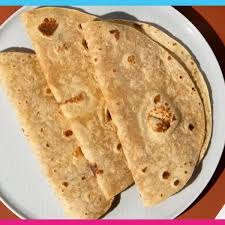
Rotis are a quintessential part of indian cuisine, and when it comes to choosing the right kind for weight loss, the flour used can make all the difference. While kuttu roti (made from buckwheat flour) and wheat roti (made from whole wheat flour) are both popular choices, they differ significantly in terms of their nutritional profile, caloric content, and health benefits.
Let’s compare the two based on several factors that influence weight loss and overall health.
1. Nutritional Content: A Look at the Basics
Kuttu Roti (Buckwheat Roti):
· Calories: Buckwheat flour is generally lower in calories than whole wheat flour, making kuttu roti a lighter option.
· Protein: Buckwheat is a rich source of plant-based protein, containing all nine essential amino acids. This makes it an excellent choice for muscle building and weight management.
· Fiber: Kuttu roti contains a good amount of fiber, which aids in digestion, controls hunger, and improves bowel health. This is particularly beneficial for weight loss.
· Micronutrients: Buckwheat is high in magnesium, iron, and antioxidants like rutin and quercetin, which are beneficial for heart health.
Wheat Roti (Whole Wheat Roti):
· Calories: Whole wheat flour tends to be slightly higher in calories than buckwheat, but it's still considered a low-calorie food compared to refined grains.
· Protein: Whole wheat is a good source of protein, but it doesn’t contain all the essential amino acids, making it less complete than buckwheat in this regard.
· Fiber: Whole wheat roti contains soluble and insoluble fiber, which aids in weight management and improves gut health. The fiber helps regulate blood sugar and controls appetite.
· Micronutrients: Whole wheat provides important nutrients like B-vitamins, iron, magnesium, and zinc, which support overall health.
2. Glycemic Index: Impact on Blood Sugar
· Kuttu Roti: Buckwheat has a low glycemic index (GI), meaning it doesn’t cause a rapid spike in blood sugar levels. This makes it a better choice for managing blood sugar levels and for weight loss because it keeps you feeling fuller for longer.
· Wheat Roti: Whole wheat has a moderate glycemic index, meaning it can cause a more gradual rise in blood sugar levels compared to refined wheat. However, it is still higher than buckwheat, making kuttu roti a better option for those specifically looking to manage blood sugar.
3. Gluten Sensitivity
· Kuttu Roti: One of the most significant advantages of kuttu roti is that buckwheat is naturally gluten-free. This makes it an excellent option for people with gluten sensitivity or celiac disease.
· Wheat Roti: Whole wheat contains gluten, which can cause digestive issues for those with gluten intolerance or sensitivity. If you’re avoiding gluten for any reason, kuttu roti would be the better choice.
4. Satiety and Digestion: Which Keeps You Fuller?
· Kuttu Roti: Due to its higher fiber content, kuttu roti can help you feel fuller for longer. The complex carbohydrates in buckwheat break down slowly, providing a steady release of energy. This makes it a great option for people looking to manage their hunger and avoid overeating.
· Wheat Roti: Whole wheat roti is also fiber-rich, which helps in digestion and promotes satiety. However, it may not keep you as full for as long as buckwheat, especially if you are on a low-calorie or low-carb diet for weight loss.
5. How to Incorporate Them for Weight Loss
Kuttu Roti for Weight Loss:
· Low in calories: Kuttu roti’s lower caloric content can help you stay within your daily calorie requirements.
· Better for fasting: Often consumed during fasts, it helps maintain energy levels while promoting fat burning without spiking blood sugar.
· Protein-rich: Its protein content helps support muscle repair and growth, which is crucial during weight loss to maintain lean body mass.
Wheat Roti for Weight Loss:
· High fiber: Its high fiber content helps with digestion, making you feel full and helping to control hunger.
· Complex carbohydrates: Wheat roti provides a steady release of energy, making it ideal for individuals who need sustained energy throughout the day, including during workouts.
6. Conclusion: Which is Healthier for Weight Loss?
· For Gluten Sensitivity: If you are sensitive to gluten or following a gluten-free diet, kuttu roti is the clear winner.
· For Weight Loss: If you are looking for a low-calorie option that offers better satiety and controlled blood sugar, kuttu roti can be a better choice for weight loss.
· For Sustained Energy: If you're looking for a more balanced meal with complex carbs, fiber, and sustained energy throughout the day, wheat roti might work better, especially if you are not gluten-sensitive.
Both are healthy choices depending on your dietary needs, so you can alternate between them based on your personal goals. If you're aiming for weight loss, consider portion control, regular exercise, and a well-balanced diet to achieve the best results!
Disclaimer:
The views and opinions expressed in this article are those of the author and do not necessarily reflect the official policy or position of any agency, organization, employer, or company. All information provided is for general informational purposes only. While every effort has been made to ensure accuracy, we make no representations or warranties of any kind, express or implied, about the completeness, reliability, or suitability of the information contained herein. Readers are advised to verify facts and seek professional advice where necessary. Any reliance placed on such information is strictly at the reader’s own risk.





 click and follow Indiaherald WhatsApp channel
click and follow Indiaherald WhatsApp channel